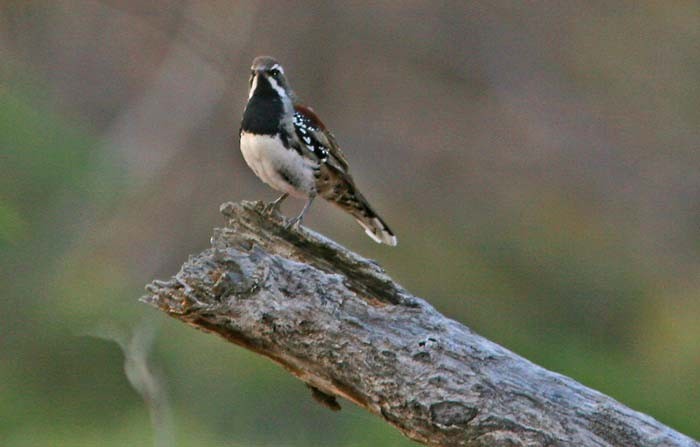Chestnut Quail-thrush
A species of Quail-thrushes, Also known as Chestnut-backed Quail-thrush Scientific name : Cinclosoma castanotum Genus : Quail-thrushes
Chestnut Quail-thrush, A species of Quail-thrushes
Also known as:
Chestnut-backed Quail-thrush
Botanical name: Cinclosoma castanotum
Genus: Quail-thrushes
Content
Description General Info
 Photo By Don Roberson
Photo By Don Roberson Description
Similar in physical appearance to other species such as Cinclosoma cinnamomeum and C.c. punctatum, the chestnut quail-thrush is a medium-sized bird that resides in the lower canopy and scrub of arid and semi-arid vegetation. The male is characterised by a rich, yellow chestnut breast, yellow to chestnut flank, with a black band that separates the white belly from the breast. The female differs with a deeper, lighter throat that lacks the black band that separates the belly from the chest, presenting an overall duller hue than the male. The difference in plumage and body size is attributed to the sexual dimorphism common amongst the Cinclosoma genus. They are known to collect in pairs and small family groups, using scrub and bushes for concealment and song perches, and running swiftly in rocketing bursts when disturbed or alarmed. The chestnut quail-thrush can be distinguished by its high-pitched call, heard as a ‘seep’ or an insect-like ‘see see see’. 
Size
26 cm
Nest Placement
Ground
Habitat
The chestnut Quail-thrush primarily inhabits mallee eucalypt woodlands with sandy soils. These areas typically feature a dense understory of various bushes and trees, including species like Acacia, Cassia, Grevillea, Hakea, Eremophila, Maireana, and Atriplex. The bird is also commonly found in spinifex-rich environments and, to a lesser extent, in mixed mallee associations such as Belah-mallee woodlands and mallee heathlands.
Dite type
Insectivorous
General Info
Feeding Habits
Bird food type
Behavior
The chestnut quail-thrush is a largely ground-based bird that favours the understorey over the canopy in order to forage, nest and hide from predators. They are a locally nomadic bird that prefers to run than fly – with or without disturbance. They are a diurnal species that forages during the day and are often seen in pairs or small family groups when foraging, nesting or singing. It has been observed that, as with other quail-thrush, they can be easily confused with a babbler when running. Easily disturbed from external activity, the chestnut quail-thrush is difficult to follow and has a practiced skill in hiding in undergrowth and scrub when threatened. The Cinclosoma castanotum is an omnivore species that feeds on a combination of ground-laden insects and seeds. They are often observed foraging through clumps of spinifex chasing insects such as grasshoppers, beetles and caterpillars, both native and exotic seed, as well as the fruit of various native plants. 
Distribution Area
The chestnut quail-thrush occurs in a relatively large area across the interior of Australia, covering both semi-arid and arid landscapes. The nominate species of Cinclosoma castanotum is found in central Queensland, extending down through the New South Wales border and continuing south as far as Cobar. The race marginatum occurs from the far southwest corner of the Northern Territory across to Shark Bay in WA and as far south as Kalgoorlie. The distribution and habitats of the chestnut quail-thrush is naturally fragmented due to natural landscape breaks, such as the Eyrean Barrier, Murchison Barrier and the desert landscapes of the Yellabinna Region – landscapes that do not support mallee or heathland and thus a lack of suitable habitat. The traditional habitat of the chestnut quail-thrush is scrub and low-lying vegetation, such as mulga-eucalyptus and acacias that reside on stony ground, as well as grevilleas and tea trees on rocky hillocks. There is a variance between habitat enjoyed by species inhabiting NSW and those in WA, with the former occurring exclusively in mallee woodlands that feature spinifex and acacia shrubs, while the latter enjoys an understorey habitat characterised by sclerophyll woodlands, acacia shrubs and heathland. Their relationship to fire regimes varies with the highest densities occurring between two and fifteen years, while densities have been observed to drop when fire intervals fall below two years. 
Species Status
The chestnut quail-thrush is listed as Least Concern under the IUCN guidelines and is in no immediate danger of extinction. Despite this, it has gone into decline in some parts of WA. This decline spreads along the western range of the marginatum contingent, specifically Kellerberrin, Dryandra and large parts of the Western Australia wheatbelt. In areas of NSW the population trend appears to be falling as well, though not fast enough to warrant a change to Vulnerable under the population trend criteria. The species – and genus at large - are vulnerable to a variety of threats, including: land clearing leading to habitat loss, fragmentation and genetic isolation; the degradation of habitat due to adjacent or immediate human activity; predation from invasive pests, such as cats and foxes; the direct and indirect challenges faced by inappropriate fire regimes, including rapid landscape change; and the unknown future threats driven by anthropogenic climate change. Potential conservation assistance strategies have been suggested, centring on reducing the stocking rates in and around potential and real habitat; retention of remnant grasslands and shrubland, aggressive control of invasive predators, and the implementation and maintenance of a sustainable fire plan. 

 Photo By Don Roberson
Photo By Don Roberson Scientific Classification
Phylum
Chordates Class
Birds Order
Perching birds Family
Whipbirds and wedgebills Genus
Quail-thrushes Species
Chestnut Quail-thrush